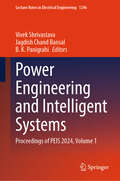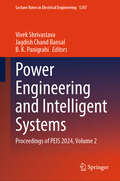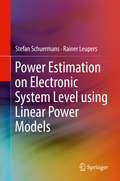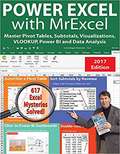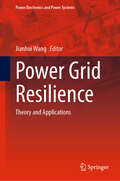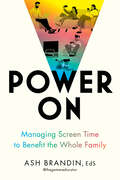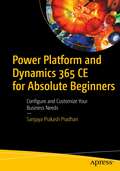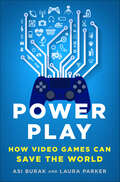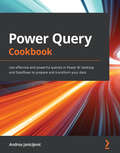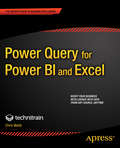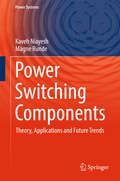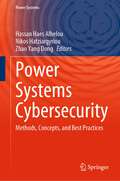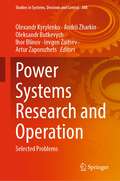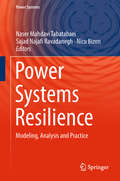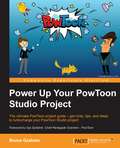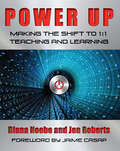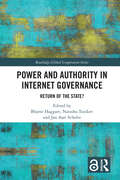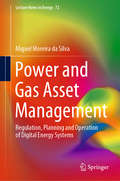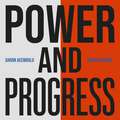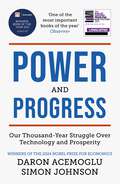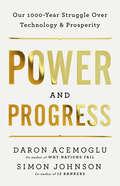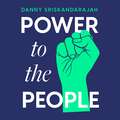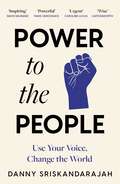- Table View
- List View
Power Engineering and Intelligent Systems: Proceedings of PEIS 2023, Volume 2 (Lecture Notes in Electrical Engineering #1098)
by Bijaya Ketan Panigrahi Jagdish Chand Bansal Vivek ShrivastavaThe book presents a collection of the high-quality research articles in the field of power engineering, grid integration, energy management, soft computing, artificial intelligence, signal and image processing, data science techniques, and their real-world applications. The papers are presented at International Conference on Power Engineering and Intelligent Systems (PEIS 2023), held during June 24 – –25, 2023, at National Institute of Technology, Delhi, India.
Power Engineering and Intelligent Systems: Proceedings of PEIS 2024, Volume 1 (Lecture Notes in Electrical Engineering #1246)
by Jagdish Chand Bansal B. K. Panigrahi Vivek ShrivastavaThis book presents a collection of the high-quality research articles in the field of power engineering, grid integration, energy management, soft computing, artificial intelligence, signal and image processing, data science techniques, and their real-world applications. The papers are presented at International Conference on Power Engineering and Intelligent Systems (PEIS 2024), held during March 16–17, 2024, at National Institute of Technology Srinagar, Uttarakhand, India.
Power Engineering and Intelligent Systems: Proceedings of PEIS 2024, Volume 2 (Lecture Notes in Electrical Engineering #1247)
by Jagdish Chand Bansal B. K. Panigrahi Vivek ShrivastavaThis book presents a collection of the high-quality research articles in the field of power engineering, grid integration, energy management, soft computing, artificial intelligence, signal and image processing, data science techniques, and their real-world applications. The papers are presented at International Conference on Power Engineering and Intelligent Systems (PEIS 2024), held during March 16–17, 2024, at National Institute of Technology Srinagar, Uttarakhand, India.
Power Estimation on Electronic System Level using Linear Power Models
by Rainer Leupers Stefan SchuermansThis book describes a flexible and largely automated methodology for adding the estimation of power consumption to high level simulations at the electronic system level (ESL). This method enables the inclusion of power consumption considerations from the very start of a design. This ability can help designers of electronic systems to create devices with low power consumption. The authors also demonstrate the implementation of the method, using the popular ESL language “SystemC”. This implementation enables most existing SystemC ESL simulations for power estimation with very little manual work. Extensive case-studies of a Network on Chip communication architecture and a dual-core application processor “ARM Cortex-A9” showcase the applicability and accuracy of the method to different types of electronic devices. The evaluation compares various trade-offs regarding amount of manual work, types of ESL models, achieved estimation accuracy and impact on the simulation speed.Describes a flexible and largely automated ESL power estimation method;Shows implementation of power estimation methodology in SystemC;Uses two extensive case studies to demonstrate method introduced.
Power Excel 2016 with MrExcel
by Bill JelenUpdating the previous edition's tips to include features in Excel 2016, this new edition of MrExcel's popular software guide even incorporates suggestions sent in by readers. Each featured topic has a problem statement and description, followed by a broad strategy for solving the problem. MrExcel then walks readers through the specific steps to solve the issue. Alternate strategies are also provided, along with common scenarios that trip users up, leaving readers with not only answers to their specific dilemmas but also new and quicker ways to use formulas and spreadsheets.
Power Grid Resilience: Theory and Applications (Power Electronics and Power Systems)
by Jianhui WangThis book provides comprehensive coverage of the resilience and reliability of power grids. It begins with the definition and theory of power grid resilience and then extends to cover the full spectrum of power grid resilience, ranging from planning to operation including system hardening, mitigation, and restoration. Practical case studies on both the bulk power system and distribution networks are included to illustrate how adaptive measures can be taken to improve the grid resilience against large-scale events. Power Grid Resilience: Theory and Applications is a state-of-the-art guide that is essential reading for practicing engineers, researchers, and scientists working in the power and energy industry. The book is also useful as a reference for undergraduate and graduate students studying power systems.
Power On: Managing Screen Time to Benefit the Whole Family
by Ash BrandinFrom "The Gamer Educator", an openminded guide to parenting alongside screens and gaming, offering practical solutions to managing your family's screen time. Parents are feeling mounting pressure to minimize screen time, but are struggling to do so in our technologically driven world. In contrast to the fear and pressure parents are facing, Ash Brandin's Power On offers a calm and reassuring message that keeps the wellbeing of the whole family in mind. Power On powerfully reframes our current dialogue around technology, beginning with the morality placed on screen time and leisure, and the systemic factors contributing to it. Brandin replaces fear with empowerment, giving caregivers tools and strategies for safely incorporating tech into their children's lives, guiding children to having a healthy relationship with screens, with easy to implement approaches such as: ·The ABCs of the Screentime Management Elements – Access, Behavior, Content ·The Managing Online Safety S.T.A.R. – Settings, Time, Ads/App Store, Restriction ·The N.I.C.E. Screentime Boundaries – Needs, Input, Consistent, Enforceable ·And several other sets of steps, tools, and strategies to understand, manage, and effectively utilize tech in parenting. With today's parenting advice being awash with unhelpful negative judgements on screens and little realistic actionable advice, Ash Brandin provides timely, realistic direction that will empower readers to find a balance with screen time that works for the entire family.
Power Platform and Dynamics 365 CE for Absolute Beginners: Configure and Customize Your Business Needs
by Sanjaya Prakash PradhanThis is your complete guide to less-code and no-code theories, along with practical application of Microsoft Power Apps and Dynamics 365 CE/CRM Apps.The book covers topics including the configurations, customizations, and enhancements in Microsoft Power Apps and Dynamics 365 CE/CRM Apps. You will start by learning Microsoft Dataverse concepts followed by Microsoft Canvas Apps, model-driven apps, and PowerApps Portals. You will understand how to work with Power Virtual Agent, Power BI, and Power Automate, and how to use AI in Power Apps. The book provides important integration concepts for Power Apps, Dynamics 365 CE/CRM Apps, and Microsoft Azure. You will know how to customize Dynamics 365 CE/CRM Apps and Power Apps using OOTB capabilities.After reading this book, you will understand how Microsoft Power Apps and Dynamics 365 CE/CRM Apps can be used, configured, and customized for your business needs using customer data. You will be able to increase efficiency in customer data management and cloud app integrations.What You Will LearnGet up to speed on the Power platform echo-system and Dynamics 365 architectureWork with DataverseUnderstand the Power platform building blocksSelect Power Apps to manage customer dataConfigure and customize Power AppsDesign robust cloud flowsIntegrate Power BI with Dynamics 365 CE/CRM AppsUnderstand the core apps in Dynamics 365 CE/CRMUse AI in Power AppsWho This Book Is ForFunctional consultants/business analysts, technical consultants/solution architects in Power Apps and Dynamics 365 CE/CRM; and beginners who want to start a career in Power Apps and Dynamics 365 CE/CRM with easy English terms
Power Play: How Video Games Can Save the World
by Laura Parker Asi Burak“An insider’s view of the good things that can emerge from being glued to a screen. . . . A solid piece of pop-culture/business journalism.” —Kirkus ReviewsThe phenomenal growth of gaming has inspired plenty of hand-wringing since its inception—from the press, politicians, parents, and everyone else concerned with its effect on our brains, bodies, and hearts. But what if games could be good, not only for individuals but for the world? In Power Play, Asi Burak and Laura Parker explore how video games are now pioneering innovative social change around the world.As the former executive director and now chairman of Games for Change, Asi Burak has spent the last ten years supporting and promoting the use of video games for social good, in collaboration with leading organizations like the White House, NASA, World Bank, and The United Nations. The games for change movement has introduced millions of players to meaningful experiences around everything from the Israeli-Palestinian conflict to the US Constitution.Power Play looks to the future of games as a global movement. Asi Burak and Laura Parker profile the luminaries behind some of the movement’s most iconic games, including former Supreme Court judge Sandra Day O’Connor and Pulitzer Prize–winning authors Nicholas Kristof and Sheryl WuDunn. They also explore the promise of virtual reality to address social and political issues with unprecedented immersion, and see what the next generation of game makers have in store for the future.
Power Query Cookbook: Use effective and powerful queries in Power BI Desktop and Dataflows to prepare and transform your data
by Andrea JanicijevicLeverage your source data from hundreds of different connections, perform millions of different transformations, and easily manage highly complex data lifecycles with Power QueryKey FeaturesCollect, combine, and transform data using Power Query's data connectivity and data preparation featuresOvercome the problems faced while accessing data from multiple sources and reshape it to meet your business requirementsExplore how the M language can be used to write your own customized solutionsBook DescriptionPower Query is a data preparation tool that enables data engineers and business users to connect, reshape, enrich, and transform their data to facilitate relevant business insights and analysis. With Power Query's wide range of features, you can perform no-code transformations and complex M code functions at the same time to get the most out of your data. This Power Query book will help you to connect to data sources, achieve intuitive transformations, and get to grips with preparation practices. Starting with a general overview of Power Query and what it can do, the book advances to cover more complex topics such as M code and performance optimization. You'll learn how to extend these capabilities by gradually stepping away from the Power Query GUI and into the M programming language. Additionally, the book also shows you how to use Power Query Online within Power BI Dataflows. By the end of the book, you'll be able to leverage your source data, understand your data better, and enrich it with a full stack of no-code and custom features that you'll learn to design by yourself for your business requirements.What you will learnUnderstand how to use Power Query to connect and explore dataExplore ways to reshape and enrich dataDiscover the potential of Power Query across the Microsoft platformBuild complex and custom transformationsUse M code to write new queries against data sourcesUse the Power Query Online tool within Power BI DataflowsImplement best practices such as reusing dataflows, optimizing expanding table operations, and field mappingWho this book is forThis book is for data analysts, BI developers, data engineers, and anyone looking for a desk reference guide to learn how Power Query can be used with different Microsoft products to handle data of varying complexity. Beginner-level knowledge of Power BI and the M Language will help you to get the best out of this book.
Power Query for Power BI and Excel
by Chris WebbPower Query for Power BI and Excel is a book for people who are tired of copying and pasting data into Excel worksheets. Power Query, part of the Microsoft Power BI suite, is a tool that automates the process of getting data into Excel and will save you hours of dull, repetitive, and error-prone work! Power Query makes it easy to extract data from many different data sources, filter that data, aggregate it, clean it and perform calculations on it, finally loading that data into either your worksheet or directly into the new Excel 2013 Data Model used by Power Pivot. This concise, practical book provides a complete guide to Power Query and how to use it to solve all of your Excel data-loading problems. Power Query for Power BI and Excel goes well beyond the surface of what Power Query can do. The book goes deep into the underlying M language, showing you how to do amazing things that aren't going to be possible from just the GUI interface that is covered in most other books. You'll have full command of the GUI, and you'll be able to drop into the M language to go beyond what the GUI provides. The depth in this book makes it a must-have item for anyone who is pushing Power BI and Excel to their limits in the pursuit of business intelligence from data analysis. Teaches the basics of using Power Query to load data into Excel Helps you solve common, data-related problems with Power Query Shows how to write your own solutions in the powerful M language What you'll learn Import data from sources including relational databases, text files, web pages, and Excel workbooks. Import from more exotic sources such as Facebook, Windows Azure Marketplace, Wikipedia, and OData feeds within and outside your organization. Build repeatable processes to filter, clean, aggregate, and transform your data. Load your data into an Excel table or directly into the Excel 2013 Data Model. Write complex expressions in Power Query's M expression language. Share queries and their data with other users in your organization. Position your data for further analysis using Power View, Power Map, Power Pivot, and the rest of Microsoft's Power BI suite. Who this book is for Power Query for Power BI and Excel is aimed at serious Excel and Power BI users who need to import data into a worksheet. Whether you are an analyst, report writer, business intelligence consultant, or just "that guy" whose job it is to prepare the monthly sales dashboard, you'll learn how Power Query can make your life easier. Power Query for Power BI and Excel is especially important for Excel and BI power users who want to work directly in the M language that underlies all of Power Query's functionality. Table of Contents Power Query and When to Use It Data Sources Transformations Tables and the Excel Data Model Expressions in the M Language Multiple Data Sources Power BI and Sharing Common Problems Solved
Power Switching Components
by Kaveh Niayesh Magne RundeThis book focuses on the theory and application of power switching components in power networks. More specifically, it discusses current interruption theory, applied stresses to switching components in power networks and appropriate methods to test their different functionalities. It reviews the basic working principles of current technologies and summarizes the upcoming technological advances within the field of power switching devices. Taking an educational approach to the subject, this book is useful for graduate courses on high voltage equipment and power device technology within the electric power engineering discipline. Furthermore, inclusion of numerous worked examples, exercises and easily digestible descriptions of complex physical phenomena in switching devices make this an invaluable self-learning resource for engineers.
Power Systems Cybersecurity: Methods, Concepts, and Best Practices (Power Systems)
by Nikos Hatziargyriou Zhao Yang Dong Hassan Haes AlhelouThis book covers power systems cybersecurity. In order to enhance overall stability and security in wide-area cyber-physical power systems and defend against cyberattacks, new resilient operation, control, and protection methods are required. The cyberattack-resilient control methods improve overall cybersecurity and stability in normal and abnormal operating conditions. By contrast, cyberattack-resilient protection schemes are important to keep the secure operation of a system under the most severe contingencies and cyberattacks. The main subjects covered in the book are: 1) proposing new tolerant and cyberattack-resilient control and protection methods against cyberattacks for future power systems, 2) suggesting new methods for cyberattack detection and cybersecurity assessment, and 3) focusing on practical issues in modern power systems.
Power Systems Research and Operation: Selected Problems (Studies in Systems, Decision and Control #388)
by Artur Zaporozhets Olexandr Kyrylenko Andrii Zharkin Oleksandr Butkevych Ihor Blinov Ievgen ZaitsevThis book examines the problems of power systems in fields related to optimization of operating modes of electric power facilities and their control systems, information and measuring systems and metrological support in the electric power industry, ensuring the functioning of the electric power system in the conditions of a competitive market of the electric power. The book is devoted to modern problems ensuring operational reliability and safety of objects integrated power system of Ukraine. It is complex task, solution of which is related to optimization of operating modes of electric power facilities and their control systems, creating diagnostic systems for the electric power industry, ensuring the functioning of the electric power system in the conditions of a competitive market of the electric power. The presented research results in book allow increasing the reliability and efficiency of operation of energy facilities and ensuring the stability of power systems, the introduction of effective methods and tools for forecasting electricity supply, optimize power systems, suggest road map to integrate electricity markets taking into account network constraints in modern conditions of electricity markets. The book includes eight chapters. A book is for researchers, engineers, as well as lecturers and postgraduates of higher education institutions dealing with problems of operation, control, diagnosis and monitoring of integrated power system, power equipment and other.
Power Systems Resilience: Modeling, Analysis And Practice (Power Systems)
by Nicu Bizon Naser Mahdavi Tabatabaei Sajad Najafi RavadaneghThis book presents intuitive explanations of the principles and applications of power system resiliency, as well as a number of straightforward and practical methods for the impact analysis of risk events on power system operations. It also describes the challenges of modelling, distribution networks, optimal scheduling, multi-stage planning, deliberate attacks, cyber-physical systems and SCADA-based smart grids, and how to overcome these challenges. Further, it highlights the resiliency issues using various methods, including strengthening the system against high impact events with low frequency and the fast recovery of the system properties. A large number of specialists have collaborated to provide innovative solutions and research in power systems resiliency. They discuss the fundamentals and contemporary materials of power systems resiliency, theoretical and practical issues, as well as current issues and methods for controlling the risk attacks and other threats to AC power systems. The book includes theoretical research, significant results, case studies, and practical implementation processes to offer insights into electric power and engineering and energy systems. Showing how systems should respond in case of malicious attacks, and helping readers to decide on the best approaches, this book is essential reading for electrical engineers, researchers and specialists. The book is also useful as a reference for undergraduate and graduate students studying the resiliency and reliability of power systems.
Power Up Your PowToon Studio Project
by Bruce GrahamWhether you are a beginner wanting to learn from a professional or a seasoned user looking for a refresher, this is the book for you.
Power Up: Making the Shift to 1:1 Teaching and Learning
by Diana Neebe Jen RobertsWherever you are on the path to 1:1 teaching and learning, you need a guide that can help you make the best use of the powerful technology available in today's classrooms. In Power Up: Making the Shift to 1:1 Teaching and Learning, Diana Neebe and Jen Roberts draw on research and their extensive experience working with teachers across subject areas and grade levels to share the keys to success when teaching with a computer or tablet for every student. This is the book secondary teachers need to understand the changes in pedagogy, planning, classroom organization, time management, and collaboration that will help them be successful in a 1:1 environment. Whether providing immediate and detailed feedback to student writers, giving voice to quiet learners, or creating more time for actual work in a jam-packed school day, Neebe and Roberts show teachers how communication, differentiation, and other effective practices can be powered up with personalized technology. Throughout the book, Neebe and Roberts coach teachers through their initial concerns about technology integration, offer advice about avoiding common problems, and encourage innovation. Using detailed classroom examples, questions, and suggestions, they provide a framework for shaping the transformation of a traditional classroom into a student-centered, technology-rich learning environment. Readers will come away with a clear sense of how a fully implemented 1:1 classroom operates. Power Up makes the transition to 1:1 a manageable and exciting journey. It's a key part of supporting teachers and ensuring the success of your 1:1 program.
Power and Authority in Internet Governance: Return of the State? (ISSN)
by Jan Aart Scholte Blayne Haggart Natasha TusikovPower and Authority in Internet Governance investigates the hotly contested role of the state in today's digital society. The book asks: Is the state "back" in internet regulation? If so, what forms are state involvement taking, and with what consequences for the future?The volume includes case studies from across the world and addresses a wide range of issues regarding internet infrastructure, data and content. The book pushes the debate beyond a simplistic dichotomy between liberalism and authoritarianism in order to consider also greater state involvement based on values of democracy and human rights. Seeing internet governance as a complex arena where power is contested among diverse non-state and state actors across local, national, regional and global scales, the book offers a critical and nuanced discussion of how the internet is governed – and how it should be governed.Power and Authority in Internet Governance provides an important resource for researchers across international relations, global governance, science and technology studies and law as well as policymakers and analysts concerned with regulating the global internet.The Open Access version of this book, available at http://www.taylorfrancis.com, has been made available under a Creative Commons Attribution-Non Commercial-No Derivatives (CC-BY-ND) 4.0 license.
Power and Authority in Internet Governance: Return of the State? (Routledge Global Cooperation Series)
by Jan Aart Scholte Blayne Haggart Natasha TusikovPower and Authority in Internet Governance investigates the hotly contested role of the state in today's digital society. The book asks: Is the state "back" in internet regulation? If so, what forms are state involvement taking, and with what consequences for the future? The volume includes case studies from across the world and addresses a wide range of issues regarding internet infrastructure, data and content. The book pushes the debate beyond a simplistic dichotomy between liberalism and authoritarianism in order to consider also greater state involvement based on values of democracy and human rights. Seeing internet governance as a complex arena where power is contested among diverse non-state and state actors across local, national, regional and global scales, the book offers a critical and nuanced discussion of how the internet is governed – and how it should be governed. Power and Authority in Internet Governance provides an important resource for researchers across international relations, global governance, science and technology studies and law as well as policymakers and analysts concerned with regulating the global internet.
Power and Gas Asset Management: Regulation, Planning and Operation of Digital Energy Systems (Lecture Notes in Energy #72)
by Miguel Moreira da SilvaThis book offers meaningful insights into an impending challenge for the energy industry, namely the increasing role of asset management amongst the utilities’ core operations. In the aftermath of energy digitalization, power and gas companies will be able to seize asset productivity—through risk-based operation and maintenance—and better balance capital and operational expenditures. By addressing the asset management of both power and gas infrastructures, and by adopting a comprehensive approach—including regulation and business models, as well as a solid technology background—this book offers a unique perspective on the energy utilities’ transformation journey and the road to optimal decision-making for both asset portfolio expansion and replacement. The asset management end-to-end mission requires appropriate internal governance—depending on the business framework—and the development of decision aid models (for asset replacement and maintenance), supported on probabilistic risk and reliability indexes. This book advocates systematically digitalizing the power and gas assets, addressing both data governance and infrastructure, alongside real-time equipment condition monitoring. It also provides a meaningful methodology for designing data-centric asset management and predictive operation and maintenance, using artificial intelligence and engineering-based approaches. As such, it provides valuable strategy, methods and models—illustrated by case studies and proofs of concept—for a wide range of stakeholders, including utilities and industry professionals, regulators, policy-makers, researchers and students.
Power and Progress: Our Thousand-Year Struggle Over Technology and Prosperity
by Simon Johnson Daron AcemogluTwo bestselling authors deliver a bold new interpretation of why technology has all too often benefited elites - and how we must reshape the path of innovation to create true shared prosperity.A thousand years of history and contemporary evidence make one thing clear. Progress is not automatic but depends on the choices we make about technology. New ways of organizing production and communication can either serve the narrow interests of an elite or become the foundation for widespread prosperity.Much of the wealth generated by agricultural advances during the European Middle Ages was captured by the Church and used to build grand cathedrals while the peasants starved. The first hundred years of industrialization in England delivered stagnant incomes for workers, while making a few people very rich. And throughout the world today, digital technologies and artificial intelligence increase inequality and undermine democracy through excessive automation, massive data collection, and intrusive surveillance.It doesn't have to be this way. Power and Progress demonstrates that the path of technology was once - and can again be - brought under control. The tremendous computing advances of the last half century can become empowering and democratizing tools, but not if all major decisions remain in the hands of a few hubristic tech leaders striving to build a society that elevates their own power and prestige.With their breakthrough economic theory and manifesto for a better society, Acemoglu and Johnson provide the understanding and the vision to reshape how we innovate and who really gains from technological advances so we can create real prosperity for all.(P) 2023 Hachette Audio
Power and Progress: Our Thousand-Year Struggle Over Technology and Prosperity
by Simon Johnson Daron Acemoglu'The blueprint we need for the challenges ahead' Shoshana Zuboff'If you are not already an addict of Daron Acemoglu and Simon Johnson's previous books, Power and Progress is guaranteed to make you one' Jared Diamond'A breathtaking tour of the history and future of technology' Abhijit Banerjee and Esther DufloA bold new interpretation of why technology has all too often benefited elites - and how we must reshape the path of innovation to create true shared prosperity.A thousand years of history and contemporary evidence make one thing clear. Progress is not automatic but depends on the choices we make about technology. New ways of organizing production and communication can either serve the narrow interests of an elite or become the foundation for widespread prosperity.Much of the wealth generated by agricultural advances during the European Middle Ages was captured by the Church and used to build grand cathedrals while the peasants starved. The first hundred years of industrialization in England delivered stagnant incomes for workers, while making a few people very rich. And throughout the world today, digital technologies and artificial intelligence increase inequality and undermine democracy through excessive automation, massive data collection, and intrusive surveillance.It doesn't have to be this way. Power and Progress demonstrates that the path of technology was once - and can again be - brought under control. The tremendous computing advances of the last half century can become empowering and democratizing tools, but not if all major decisions remain in the hands of a few hubristic tech leaders striving to build a society that elevates their own power and prestige.With their breakthrough economic theory and manifesto for a better society, Acemoglu and Johnson provide the understanding and the vision to reshape how we innovate and who really gains from technological advances so we can create real prosperity for all.
Power and Progress: Our Thousand-Year Struggle Over Technology and Prosperity
by Simon Johnson Daron AcemogluThe bestselling co-author of Why Nations Fail and the bestselling co-author of 13 Bankers deliver a bold reinterpretation of economics and history that will fundamentally change how you see the world A thousand years of history and contemporary evidence make one thing clear: progress depends on the choices we make about technology. New ways of organizing production and communication can either serve the narrow interests of an elite or become the foundation for widespread prosperity. The wealth generated by technological improvements in agriculture during the European Middle Ages was captured by the nobility and used to build grand cathedrals, while peasants remained on the edge of starvation. The first hundred years of industrialization in England delivered stagnant incomes for working people. And throughout the world today, digital technologies and artificial intelligence undermine jobs and democracy through excessive automation, massive data collection, and intrusive surveillance. It doesn&’t have to be this way. Power and Progress demonstrates the path of technology was once—and may again—be brought under control. Cutting-edge technological advances can become empowering and democratizing tools, but not if all major decisions remain in the hands of a few hubristic tech leaders. With their bold reinterpretation of economics and history, Daron Acemoglu and Simon Johnson fundamentally change how we see the world, providing the vision needed to redirect innovation so it again benefits most people.
Power to the People: Use your voice, change the world
by Danny SriskandarajahDanny Sriskandarajah learned the value of citizenship at a young age as the child of Tamil migrants who moved from Sri Lanka to Australia. Arriving in the UK as the first Rhodes scholar from an Asian immigrant background, he has gone on to run a series of civil society organisations, and has become a leading voice in the third sector.POWER TO THE PEOPLE is his radical manifesto for change designed to inspire citizen action around the world. The book presents a blueprint for how we, as individuals, can make a difference through greater community engagement, and how we can deliver a society that works for the many and not the few. He speaks to voter apathy and a growing sense that elections no longer matter, with politicians and institutions too focused on short-term issues to grapple with complex global problems such as climate change, rising inequality, and digital disruption. Yet the book is also filled with inspiring real-life examples of citizen power in action, ranging from a volunteer-run repair café in Danny's local suburb to Avaaz's successful campaigns to tackle endemic corruption in Brazil.From public ownership of social media spaces to democratising share ownership, and from re-energising co-operatives to creating a people's chamber at the United Nations, this campaigning book has a clear mission to make us reclaim our power as citizens of the world.
Power to the People: Use your voice, change the world
by Danny SriskandarajahDanny Sriskandarajah learned the value of citizenship at a young age as the child of Tamil migrants who moved from Sri Lanka to Australia. Arriving in the UK as the first Rhodes scholar from an Asian immigrant background, he has gone on to run a series of civil society organisations, and has become a leading voice in the third sector.POWER TO THE PEOPLE is his radical manifesto for change designed to inspire citizen action around the world. The book presents a blueprint for how we, as individuals, can make a difference through greater community engagement, and how we can deliver a society that works for the many and not the few. He speaks to voter apathy and a growing sense that elections no longer matter, with politicians and institutions too focused on short-term issues to grapple with complex global problems such as climate change, rising inequality, and digital disruption. Yet the book is also filled with inspiring real-life examples of citizen power in action, ranging from a volunteer-run repair café in Danny's local suburb to Avaaz's successful campaigns to tackle endemic corruption in Brazil.From public ownership of social media spaces to democratising share ownership, and from re-energising co-operatives to creating a people's chamber at the United Nations, this campaigning book has a clear mission to make us reclaim our power as citizens of the world.

